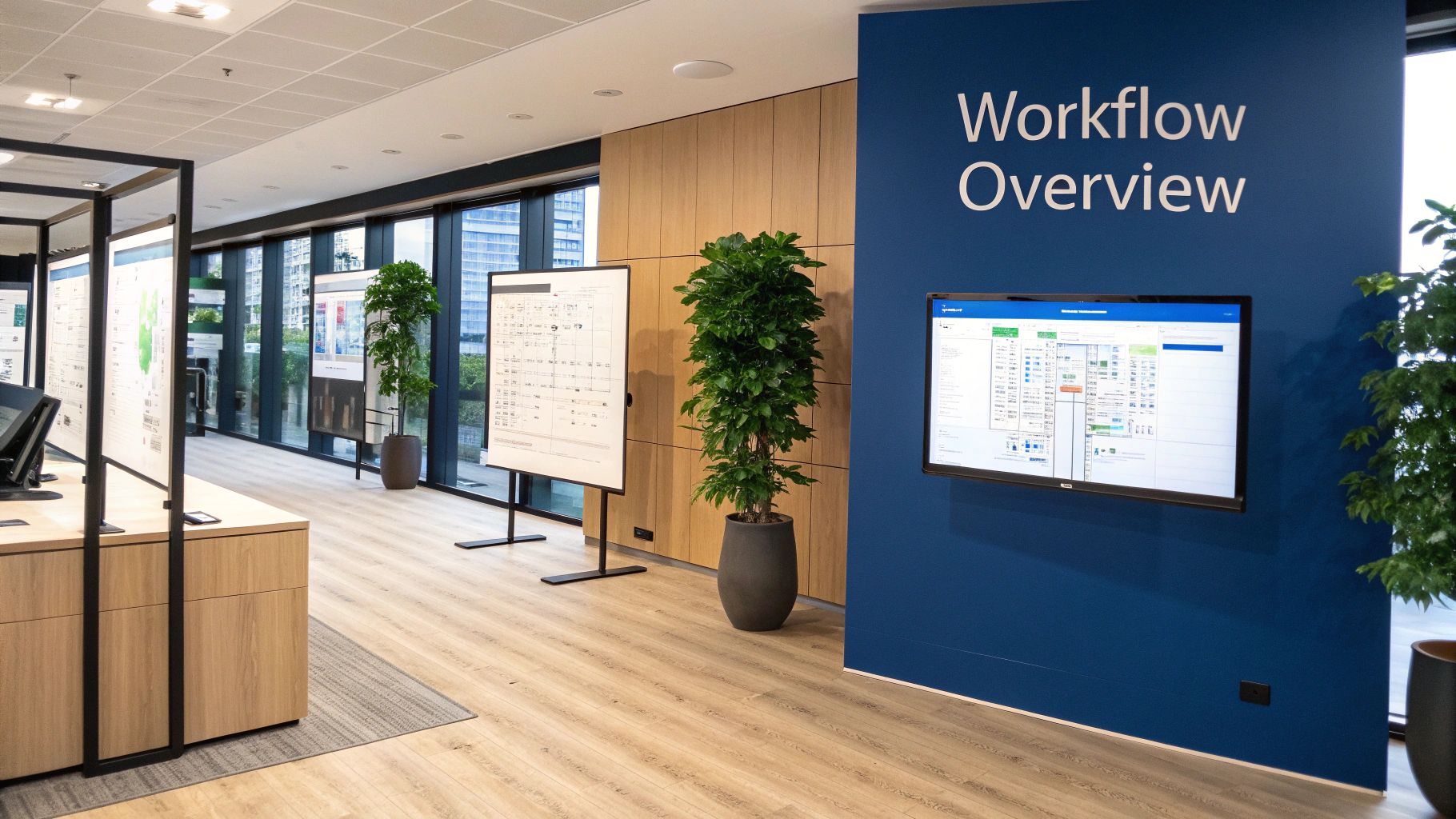Boost Efficiency with Workflow Analysis Template
The Power of Structured Process Evaluation

Does it ever feel like your team is constantly reacting to problems instead of proactively moving forward? This often comes down to inefficient workflows. This is where workflow analysis templates come into play. They provide a structured way to understand, evaluate, and improve how work gets done.
A workflow analysis template is more than just a simple checklist. It’s a powerful tool that allows you to dissect your processes, uncovering hidden inefficiencies and opportunities for improvement. For example, a template can help identify bottlenecks, repetitive tasks, and communication gaps that hinder productivity.
This structured approach helps you understand how different parts of a process interact, leading to better decisions about how to make improvements. This translates directly into tangible results. By using these templates, companies can streamline their processes and boost efficiency.
Studies show that implementing workflow analysis can significantly reduce operational costs. In one case study, a company reduced its operational costs by 25% simply by identifying and removing bottlenecks in its workflow. This not only saves money, but also boosts productivity and employee morale. Learn more about workflow analysis. Workflow analysis templates offer a structured approach to identifying these bottlenecks and optimizing workflows. This makes them an essential tool for any business seeking to improve profits.
Why Structure Matters in Process Evaluation
Structured process evaluation, made easier with workflow analysis templates, offers several key benefits:
- Consistency: Templates ensure a standardized approach to analysis, reducing bias and increasing the reliability of the findings.
- Clarity: They break down complex processes into smaller, easier-to-understand steps, making analysis more manageable.
- Collaboration: Templates provide a shared language for discussing workflows, which improves team communication and collaboration.
- Actionable Insights: By pinpointing areas for improvement, templates enable targeted actions that lead to real, measurable change.
These benefits contribute to greater efficiency, cost savings, and better overall performance. The structured approach encourages a culture of continuous improvement, providing a framework for regular monitoring and optimization. Game-Changing Workflow Automation Benefits for Business Success provides a helpful guide on this topic. Through ongoing evaluation, organizations can identify and address emerging issues, adapting their workflows to changing business needs to maintain both efficiency and effectiveness.
Building Blocks of Effective Workflow Analysis Templates

What separates a truly effective workflow analysis template from a simple checklist? It's the core components that transform these templates into powerful instruments for achieving operational excellence. These components work in concert to provide a thorough understanding of your business processes, allowing for focused improvements.
Key Components of a Robust Workflow Template
A well-designed workflow analysis template should incorporate several key elements. These elements combine to deliver a complete overview of the process, from initiation to completion.
- Process Mapping: This involves visually documenting the steps within a workflow. Well-defined process maps demonstrate the sequence of activities, revealing dependencies and potential bottlenecks. This visual representation makes it easier to grasp and analyze the entire workflow.
- Role Definition: Clearly outlining the roles and responsibilities for each step is critical. This helps pinpoint potential overlaps, gaps, or uncertainties in responsibilities, promoting accountability and a more efficient execution.
- Timeline Tracking: This involves estimating the time needed for each step in the workflow. By tracking timelines, you can identify time-consuming tasks and work towards optimizing them for improved overall efficiency.
- Outcome Measurement: Establishing clear metrics for assessing the success of the workflow is vital. These metrics offer a foundation for gauging progress and ensuring the workflow meets its intended goals. This data-driven approach supports continuous improvement.
These fundamental elements build a framework for evaluating and improving workflows. Consider a customer service process as an example. By mapping the steps, defining roles, tracking timelines, and measuring resolution times, businesses can make targeted improvements that enhance both customer satisfaction and operational efficiency.
The following table provides a more structured look at these essential components:
Essential Components of Workflow Analysis Templates
| Component | Purpose | Implementation Considerations |
|---|---|---|
| Process Mapping | Visually represent the steps in a workflow. | Use flowcharts or diagrams to illustrate the sequence of activities, highlighting decision points and dependencies. |
| Role Definition | Specify responsibilities for each step. | Create a RACI matrix (Responsible, Accountable, Consulted, Informed) to clarify roles and avoid confusion. |
| Timeline Tracking | Estimate time required for each step. | Use historical data or time-tracking software to establish realistic timeframes. Consider potential delays and buffers. |
| Outcome Measurement | Define metrics to evaluate workflow success. | Choose relevant metrics aligned with business objectives. Track data consistently and analyze for trends and areas for improvement. |
This table summarizes the core elements of an effective workflow template, offering a guide for implementation and analysis. By using these components, organizations can gain valuable insights into their operations and identify areas for improvement.
Adapting Templates to Your Needs
While these core components are generally applicable, the specifics of a workflow analysis template should be adjusted to your unique business needs. This customization ensures relevance and maximizes the impact of the analysis. Every business has its own nuances, so your template should reflect your specific operational environment.
For instance, a manufacturing company might emphasize timeline tracking to minimize production delays, while a software company might prioritize outcome measurements related to resolving bugs and releasing new features. This flexibility makes workflow analysis templates valuable tools across diverse industries and organizational structures. The key is to tailor proven frameworks to your processes and the challenges you face. Carefully consider your industry, operational maturity, and specific aims to customize your workflow analysis template for optimal effectiveness.
Transforming Data Into Visual Insights

A well-structured workflow analysis template provides the raw data needed for process improvement. However, raw data alone can be difficult to interpret. This is where data visualization comes in. Transforming this data into visual insights makes identifying trends, bottlenecks, and areas for improvement much easier.
Visualizing data within a workflow analysis template isn't about aesthetics. It's about uncovering the story within the data. This allows stakeholders at all levels to quickly understand complex information, leading to faster, more informed decisions. For example, a simple flowchart can visually represent the workflow, instantly highlighting dependencies and potential bottlenecks.
Choosing the Right Visualization Technique
Different visualization techniques serve different purposes within a workflow analysis template. The best method depends on the specific data and the insights you're looking for.
- Flowcharts: These diagrams visually represent the steps in a process. They're particularly useful for understanding complex workflows and identifying areas for simplification.
- Swimlane Diagrams: Similar to flowcharts, swimlane diagrams add a layer of accountability. They show which team or individual is responsible for each step, highlighting potential communication or handoff issues.
- Heat Maps: These use color variations to represent the intensity of data points. In a workflow analysis template, heat maps can show the frequency of errors, bottlenecks, or high-activity areas, quickly highlighting areas needing improvement.
- Gantt Charts: These charts visualize project schedules and dependencies. They're helpful within a workflow analysis template for identifying critical tasks and potential delays.
These are just a few examples of visualization techniques that can enhance a workflow analysis template. Data visualization is essential for workflow analysis. Visualizing data allows businesses to quickly identify areas for improvement and spot trends. For instance, a marketing team might use data visualization tools like Tableau to track an email campaign's open rates, click-through rates, and conversions. This visual approach simplifies complex data, leading to better decision-making. Data visualization is now crucial for big data projects, enabling better interpretation of large datasets. Learn more about data visualization here.
Communicating With Visuals
Visualizations within a workflow analysis template should be clear, concise, and easy to understand. They act as a communication tool, conveying complex information in an accessible way to both technical and non-technical audiences.
By using a combination of these visualizations, organizations gain a comprehensive view of their workflows and can drive aligned improvement efforts across departments. This visual approach simplifies communication and helps build consensus around proposed changes.
From Insights to Action
The ultimate goal of visualizing data within a workflow analysis template is to drive action. By clearly highlighting areas for improvement, visualizations empower teams to implement changes that deliver tangible results. The insights gained from visual analysis can then be used to streamline operations, optimize resource allocation, and ultimately improve organizational performance.
From Paper Forms to Digital Transformation

Workflow analysis has come a long way, mirroring the technological leaps we've witnessed across various industries. Not so long ago, analyzing a workflow involved clipboards, stacks of paper forms, and hours of manual data entry. This traditional method was not only slow and prone to errors, but it also offered limited analytical depth.
This manual and time-intensive approach often resulted in project delays and operational inefficiencies, hindering organizations from achieving peak performance. The advent of digital tools, however, has revolutionized workflow analysis.
This digital transformation has significantly improved the efficiency and effectiveness of workflow analysis. Dedicated software and workflow analysis templates offer a more structured, data-driven methodology. This saves valuable time and provides more accurate, insightful analyses.
Digital tools also facilitate real-time data collection, automated reporting, and seamless information sharing across teams. This improved collaboration ensures everyone operates with the most current data, leading to better decision-making. Tools like Google Sheets provide robust features for analyzing data and deriving actionable insights. For a deeper dive into data analysis with Google Sheets, check out this guide on calculating percentages: Advanced Google Spreadsheet: Calculate Percentage in Google Sheets - A Step-by-Step Guide. By automating tedious tasks, these tools empower businesses to prioritize strategic improvements over manual data collection.
The Impact of Integrated Workflow Systems
Modern integrated workflow systems boast capabilities that were once unimaginable. Real-time insights, automated alerts, and advanced reporting tools allow organizations to proactively monitor performance and pinpoint areas for improvement. This proactive approach allows for addressing potential issues before they escalate, minimizing disruptions and optimizing efficiency.
These systems not only offer a clear view of current operations but also provide predictive capabilities. By analyzing historical data and identifying trends, businesses can anticipate future bottlenecks or challenges and implement preemptive measures. This forward-thinking approach is critical for maintaining a competitive advantage. For further reading on optimizing document-related workflows, see: Document Management Best Practices: The Ultimate Guide.
Unlocking New Levels of Efficiency
One of the most significant benefits of digital workflow analysis tools is their ability to unlock new levels of efficiency. By automating repetitive tasks, streamlining communication, and providing instant access to crucial data, these tools free up valuable time and resources.
This allows employees to focus on higher-value activities that directly contribute to business growth and foster innovation. This shift empowers businesses to optimize operations in ways previously impossible, from reducing processing times and minimizing errors to improving communication. Digital workflow analysis tools are indispensable for organizations striving to enhance performance and achieve their strategic objectives.
From Analysis to Action: Implementation Strategies
Creating a well-designed workflow analysis template is a crucial first step. However, the real benefit comes from effectively putting that analysis into action. This section explores the vital steps that turn analysis into tangible improvements. We'll cover everything from initial setup and getting stakeholder buy-in to practical techniques for collecting useful data. Successfully implementing these strategies is how you unlock the full potential of workflow analysis.
Preparing for Implementation
Before starting the analysis, thorough preparation is essential. This preparation sets the stage for a successful implementation. It involves clearly defining the scope of the analysis, identifying key stakeholders, and establishing clear objectives. This groundwork ensures that everyone involved understands the goals and is working towards a common outcome.
Engaging stakeholders is paramount. Involving those directly impacted by the workflow helps secure their support and reduces resistance to future changes. This collaborative approach creates a sense of ownership and makes implementation smoother.
Data Collection Techniques That Work
Gathering relevant and trustworthy data is crucial for an effective analysis. Methods like direct observation, interviews, and surveys offer rich qualitative data. These methods offer insights into the human side of the workflow. This qualitative data complements quantitative data, providing a more complete picture.
Furthermore, automated data collection using software like Zapier or Integromat provides objective quantitative data. These tools can track metrics such as processing time and error rates. This hard data provides a clear view of current performance, highlighting specific areas for improvement.
Overcoming Implementation Challenges
Implementation often comes with its own set of obstacles. Common challenges include resistance from employees used to existing workflows, concerns about data quality, and the risk of “analysis paralysis.” Analysis paralysis occurs when overthinking the process leads to delayed action. Addressing these challenges directly is essential for maintaining project momentum.
Open communication and ongoing stakeholder engagement are key to overcoming these challenges. Explaining the advantages of the analysis, addressing concerns transparently, and involving employees in the improvement process builds support and reduces resistance. This collaborative approach turns potential roadblocks into chances for growth.
Maintaining Momentum and Translating Findings
Maintaining momentum throughout the implementation process is vital. Regular progress updates, open communication, and celebrating early wins keep the team engaged and motivated. This positive reinforcement encourages continued effort and a focus on long-term goals.
For a more detailed look at optimization strategies, take a look at our guide on Essential Process Improvement Techniques: A Strategic Guide. This guide offers valuable insights and practical steps for making lasting improvements. Ultimately, the goal is to translate the analysis findings into real, sustainable improvements. This involves implementing changes, monitoring their effect, and adjusting as needed. This iterative approach ensures the analysis results in positive, lasting change.
To help visualize the implementation process, the table below outlines the key phases, associated activities, common challenges, and indicators of success.
Workflow Analysis Implementation Phases
| Implementation Phase | Key Activities | Common Challenges | Success Indicators |
|---|---|---|---|
| Preparation | Defining scope, identifying stakeholders, setting objectives | Lack of clarity, stakeholder resistance | Clearly defined objectives, stakeholder buy-in |
| Data Collection | Gathering data through various methods (observation, interviews, surveys, automated systems) | Data quality concerns, incomplete data | Accurate and comprehensive data collected |
| Analysis | Evaluating data, identifying bottlenecks and improvement areas | Analysis paralysis, data misinterpretation | Actionable insights identified, clear recommendations developed |
| Implementation | Implementing recommended changes, monitoring impact | Employee resistance, technical difficulties | Successful adoption of changes, measurable improvements in metrics |
| Evaluation | Assessing the impact of changes, making adjustments as needed | Lack of follow-up, difficulty measuring impact | Measurable and sustained positive change achieved |
This table serves as a roadmap for navigating the workflow analysis implementation process. By proactively addressing potential challenges and focusing on the key success indicators, organizations can ensure their efforts lead to meaningful and sustainable improvements.
Beyond Business: Workflow Templates Across Industries
Workflow analysis templates are powerful tools for optimizing processes, extending beyond traditional business settings. Their adaptability makes them valuable across diverse sectors, revolutionizing how organizations operate and achieve their goals. From healthcare to creative agencies, these templates improve efficiency and drive success.
Healthcare: Streamlining Patient Care
Efficient workflows are crucial in the fast-paced world of healthcare. Hospital emergency departments, for instance, use workflow analysis templates to improve patient flow and reduce wait times. By mapping processes and identifying bottlenecks, hospitals achieve significant improvements in patient care. Some hospitals have seen a 37% reduction in patient wait times after implementing these strategies, resulting in faster treatment and improved outcomes.
Scientific Research: Accelerating Discoveries
Workflow templates play a vital role in scientific research, ensuring consistency and efficiency in complex analyses. Researchers in fields like pharmacokinetics use these templates within specialized software like Phoenix to automate repetitive analyses. This ensures reliability and streamlines the process, which is particularly important in time-sensitive research. Learn more about workflow analysis in scientific research here.
Manufacturing: Enhancing Production Efficiency
Manufacturing industries greatly benefit from workflow analysis templates, especially with complex production processes. Mapping each stage, from raw materials to finished goods, helps manufacturers identify and address inefficiencies. These templates also facilitate quality control, ensuring production meets required standards. This optimization minimizes waste, reduces costs, and improves overall production output.
Creative Agencies: Managing Creative Projects
Even creative fields like advertising and film production utilize workflow analysis templates. Film production companies, for example, use them to manage complex projects, from pre-production to post-production. This structured approach helps control costs, manage resources, and deliver projects on time and within budget, ensuring high quality while maintaining efficiency.
Cross-Industry Learning: Accelerating Innovation
The adaptability of workflow analysis templates allows for valuable cross-industry learning. By examining applications in different sectors, organizations gain insights and adapt successful strategies. This exchange of ideas accelerates innovation and drives continuous process improvement in unexpected ways, benefiting businesses across various sectors.
Specialized Applications and Considerations
While core workflow analysis principles remain consistent, each industry has specific considerations. Healthcare focuses on patient safety and regulatory compliance, while manufacturing prioritizes production efficiency and quality control. Recognizing these unique needs is crucial for effective implementation. Understanding these nuances allows organizations to customize templates and address industry-specific challenges.
Creating a Culture of Continuous Improvement
Workflow analysis, done effectively, isn't a one-off project. It's an ongoing process. Successful organizations recognize that continuous improvement is essential for remaining competitive and adaptable. They build systems for evaluating workflows, establishing cycles of analysis and refinement. This ensures workflow analysis becomes ingrained in the organizational culture, not just another forgotten initiative.
Establishing Baseline Metrics and Targets
Before improving a workflow, you must understand its current state. This involves establishing baseline metrics. These metrics provide the starting point for measuring progress. For example, a baseline metric for a customer service workflow might be the average time it takes to resolve an issue.
Once you have baseline metrics, you can establish achievable targets for improvement. These targets should be ambitious yet realistic, challenging the team to improve without being discouraging. Perhaps the target is to reduce the average customer issue resolution time by 15% within three months.
Tracking progress toward these targets demonstrates the return on investment (ROI) of workflow analysis to stakeholders. This data-driven approach provides evidence of the value of continuous improvement and encourages continued support for these initiatives.
Embedding Continuous Optimization in Your Culture
Creating a culture of continuous improvement requires more than just setting targets. It involves building a mindset where everyone actively seeks ways to enhance processes. This requires buy-in from all levels of the organization. Leaders should advocate for workflow analysis and empower employees to suggest and implement improvements.
Regular reviews of workflows should be scheduled, creating opportunities to pinpoint areas for optimization and refine existing processes. This might involve monthly meetings to discuss workflow performance and brainstorm improvement ideas. This ongoing evaluation helps teams adapt to changes in the business environment and stay ahead of the curve.
Practical Tools for Sustaining Momentum
Several practical tools can help maintain momentum in continuous improvement efforts. These include:
- Feedback Mechanisms: Implement systems for gathering feedback from employees involved in the workflow. This could involve regular surveys or suggestion boxes. Direct input from those actively using the workflow is invaluable.
- Visual Management Tools: Use visual tools like dashboards) to track key metrics and progress toward targets. This transparency keeps the team informed and motivated.
- Recognition and Rewards: Recognize and reward individuals and teams who contribute to workflow improvements. This positive reinforcement strengthens the culture of continuous improvement.
By implementing these strategies, organizations can ensure that workflow analysis becomes deeply embedded in their operations. This creates a team that instinctively seeks opportunities to enhance processes, driving both efficiency and effectiveness throughout the organization.
Ready to optimize your workflows and increase productivity? Whisperit, an AI-powered dictation and text editing platform, can help streamline your document creation and management processes. Visit Whisperit to learn more and start your free trial.